
Do you want to learn about using SEO for digital products?
When managing an eCommerce store, it’s important to make sure your digital products reach the right people.
SEO is a core marketing tactic that helps ensure your site appears in the search engines. Understanding the basics of SEO and how to optimize your digital product pages can help you drive traffic to your site and boost conversions.
🔎 In this article, I’ll cover:
What Is SEO?
Search engine optimization (SEO) is the process of optimizing your website and its content to improve its ranking in search engine results pages (SERPs).
It’s the art and science of making your website and products friendly to search engines like Google, so they understand what you offer and rank you higher in search results for relevant keywords.
At its most fundamental level, SEO is a method for connecting people with the information they seek. SEO essentially utilizes a system of collecting information from web pages on the internet and running it through a search engine-specific algorithm to deliver the best possible results.
This is important for digital sellers, entrepreneurs, and online businesses of all sizes because it can help you attract more organic traffic to your website, which can lead to more sales and conversions.
Importance of SEO for Digital Products
If people can’t find you, they can’t buy from you. This is what makes SEO for digital products so important.
Organic search (people searching for things, not ads) drives a massive chunk of online traffic – over 53% to be exact! So, ranking higher in search results means more potential customers discovering your products.
There are many benefits to using SEO for digital products and eCommerce websites, including:
- Increased organic traffic: When your website ranks higher in SERPs, more people will see it, which can lead to more clicks and visitors to your site.
- Improved brand awareness: As your website visibility increases, so will your brand awareness. This can help you attract new customers to your small business and establish yourself as a leader in your industry.
- Higher conversion rates: When people find your website through organic search, they are already interested in what you have to offer, which can lead to higher conversion rates.
- Cost-effective digital marketing: SEO is a relatively cost-effective strategy to market your products and services compared to other methods such as paid advertising (like pay-per-click or PPC campaigns).
How SEO for Digital Products Works
How does SEO actually work? It’s like a secret handshake with search engines. They send out crawlers (think tiny robotic spiders) to scour the web, indexing websites and their content. To help them understand your products, you need to speak their language.
SEO works by sending signals to search engines about the relevance and quality of your website. These signals include:
- On-page SEO: This refers to the optimization of individual web pages on your website, such as your title tags, meta descriptions, header tags, etc. It’s important to make sure your website content is clear, engaging, and informative, and that you have catchy titles, well-structured descriptions, and high-quality images.
- Off-page SEO: This refers to factors outside of your website that can influence your ranking, such as backlinks from other websites. Imagine other websites vouching for you with a thumbs-up. Earning backlinks, also known as link building, from reputable websites signals to search engines that your content is valuable and trustworthy, boosting your ranking.
- Technical SEO: This refers to the technical, behind-the-scenes aspects of your website that can affect its crawl ability and indexability by search engines. Things like fast loading speeds, mobile-friendliness, and secure connections are key.
Plenty of digital product business owners are often left frustrated and unsure of how to maximize their exposure through SEO. Fortunately, there are some effective tricks you can learn to master SEO and push your online store to the top of the heap.
First, let’s take a look at some of the essential elements.
Basic Elements of SEO
I’ve provided a brief introduction to SEO. Now let’s get down to the nuts and bolts of SEO for digital products on a fundamental level.
Keywords
Keywords are the words and phrases people use to search for things. Keyword research is the process of identifying the relevant keywords and search terms related to your products that your target audience is searching for.
Think of keywords as breadcrumbs leading search engines to your door. They’re the words and phrases you’ll sprinkle throughout your website content, titles, and descriptions.
Long-tail keywords refer to the lengthier search terms that are more specific and have lower competition compared to broad keywords.
The more specialized you get in narrowing down your keywords, the better chance you have of a high ranking. This is because common single keywords can come with a lot of competition.
For example, the keyword “flowers” is general enough to produce results for anything related to floral design, flower shops, flower patterns, flower photography, and botanical information.
On the other hand, a long-tail keyword like “floral design San Jose” is specific enough to produce accurate results for floral designers in San Jose. Plus, there’s less competition with other websites.
Metadata
Metadata provides search engines with snippets and information about your site, including the title, description, and keywords.
To be successful with SEO for digital products, you’ll want to make sure your metadata is accurate, concise, and descriptive. There are some specific strategies for each type of metadata that you want to take into consideration.
Titles
When we talk about title tags we are referring to the section of HTML in the page source that specifies the title of a web page – one of the key ingredients that informs search engines about the page topic.
Title tags are the first clickable lines of text the user sees in their search results.
With digital product pages, you’ll want to include the product title itself in the title tag. Naming your products appropriately, including primary keywords, helps your target audience find them, and establishes your store as a source for those product types.
It also helps boost page rankings and click-through rates (CTR; how many times your title is clicked on in search results) for those keywords.
Descriptions
In search engines, meta descriptions are text below the title tag that describes what the page is all about. The meta description is a great opportunity to communicate to the user why they should click through and visit the page, and it can utilize keywords just like the other SEO components.
Generally speaking, including one or more keywords in the description that you’ve also used in the title lets the search engines know that the topic is consistent with the title. Keeping it straight and to the point helps customers get a feel for the content quicker. Accuracy and descriptiveness are hugely important, as Google (for example) may reassign content from elsewhere on the page if it deems the description inadequate.
When it comes to SEO for digital products and product pages, you’ll want to include information like the key features and other descriptive elements that let users know what the product is, what it’s for, its purpose and inspiration, or background information. Google even pulls pricing information from product pages. It’s incredibly important that your digital product copy is not only engaging, but also keyed to highly-searched phrases so your site has a better chance of appearing in search results.
Links
When it comes to establishing your digital product store as an authority within your niche and ranking highly among the many search results on the internet, link building is essential. In fact, links are one of Google’s three most influential factors for ranking.
This is largely due to how the newer algorithms analyze web pages. Content is still crucial, however, the amount of links coming into the page has become hugely important.
Some important things to remember:
- The anchor text (clickable text) of a link should match the content it’s linking to. However, excessive keywords and exact matches can be treated like spam.
- Authority is key; links coming to you from more established and popular sources will have a greater effect on your rankings.
- Links from pages within your niche or relevant to your main topic(s) are more effective.
- Editorial links (links placed within content) are given more weight, as “unnatural links” can violate Google guidelines.
- Google and other search engines may penalize you if there are a lot of lower-quality links going to your site.
User Intent
In the context of SEO, user intent refers to the underlying reasons or goals a user has for entering specific search queries into search engines. It essentially answers the question “Why is this user searching for this?”.
Understanding user intent is crucial for effective SEO because it allows you to optimize your content to match the user’s needs and expectations. Remember, the whole point is to give users exactly what they’re looking for with as little digging as possible.
So, while keywords may still be a fundamental part of the equation, delivering results relevant to the query, user intent goes one step further and filters according to user needs.
Satisfying user intent is considered a significant SEO ranking factor as it demonstrates the value and relevance of your content. When you produce fresh and relevant content that meets user needs regularly, you’ve successfully integrated user intent into your SEO efforts.
Authority
In the context of SEO, authority refers to the perceived credibility, trustworthiness, and expertise of a website in the eyes of search engines like Google. Websites with higher authority tend to rank higher in search results for relevant keywords.
The reputation your site develops over time can greatly influence your rankings, as search engines will come to know your site as an in-demand source for related search queries.
In addition to getting all of your SEO ducks in a row, the best thing you can do is produce regular content that is fresh, interesting, and relevant to your audience. The more of an authority you become within your niche, the more traffic you’ll get from search results and backlinks, bumping your ranking up and increasing your brand reach overall.
SEO for Digital Products: Tips & Best Practices
Ready to get started with SEO for digital products on your eCommerce site? Below are some tips and best practices to follow for digital SEO.
1. Conduct Thorough Keyword Research
One of the first steps you should take when developing and implementing an SEO strategy for your online store is to spend time conducting keyword research.
Use tools like Google Keyword Planner, SEMrush, and Ahrefs to find relevant keywords with good search volume and low competition. Target long-tail keywords (more specific phrases) instead of just broad one-word terms.
2. Create Quality Content
When it comes to SEO, content is king. The effectiveness of content marketing has been proven over and over again. It’s one of the best ways to provide value to your niche community while bringing in new website visitors and potential customers at the same time.
Therefore, to help boost your SEO for digital products, create high-quality, informative, and engaging content that is relevant to your target audience.
In addition to well-structured product pages, sales pages, and other pages on your website, this includes blog posts. Publish informative articles and guides that address user needs and integrate keywords naturally.
3. Consider User Intent
When creating your SEO and content marketing strategy, consider user intent. In other words, understand what users are searching for and tailor your content accordingly.
Create content that aligns with different buyer journey stages, such as informational, research, and transactional.
For example:
| Stage | User Goal | Example |
|---|---|---|
| Informational | Find information & comparisons | “best laptops for students” |
| Transactional | Purchase a product | “Buy running shoes online” |
| Navigational | Locate a specific website | “Wikipedia” |
Optimizing for user intent leads to a better user experience. If users find what they’re looking for on your website, they are more likely to stay engaged, convert into potential customers, and potentially share your content, further boosting your SEO.
4. Optimize Your Product Pages
Of course, when it comes to implementing SEO for digital products, it’s important to focus on your product pages. There are a variety of ways you can optimize product pages, including:
- Include your target keywords in titles, descriptions, URLs, meta descriptions, & file names
- Use unique keywords for each page
- Write detailed & informative product descriptions that address user pain points & highlight features & benefits
- Use high-quality images & videos showcasing your products
- Include relevant keywords naturally throughout the content, without keyword stuffing
- Utilize product tags & categories for better organization & discoverability
You can use tools like AIOSEO to preview how your titles will appear in search results. You may decide to adjust your titles based on character count, width limitations, or user behavior. For example, if you have a predominantly mobile audience, use shorter titles (under 60 characters is a safe bet).
5. Focus on UX & Technical SEO
SEO is ultimately about serving your audience. If your website is confusing or frustrating, people will bounce, and search engines will notice.
Therefore, when implementing SEO for digital products on your site, focus on technical SEO and other aspects that influence the user experience.
Some ways to do this include:
- Ensure your website is mobile-friendly for optimal user experience
- Submit your website & product pages to search engines for indexing
- Ensure clear & easy navigation for users & search engines
- Link to relevant product pages & blog posts from other areas of your site
- Address website speed, Core Web Vitals, & structured data
6. Incorporate Social & Email Marketing
While social media and email marketing don’t directly impact search engine algorithms, they can be valuable tools to drive targeted traffic, build brand awareness, and encourage user engagement—all of which can indirectly contribute to improved SEO for your digital products and eCommerce website.
Use social media and email marketing campaigns to promote new products, blog posts, and special offers. Regular interaction and engagement on social media platforms can build brand awareness and establish your brand as an authority in your niche. This can indirectly improve search engine ranking factors like brand mentions and sentiment.
Social and email channels can also be excellent for demonstrating social proof. Positive customer reviews and testimonials can build trust and credibility, potentially influencing users to click on your website from search results.
7. Don’t Try to Trick Google
Years ago, you may have gotten away with things like low-quality, irrelevant backlinks, keyword stuffing (grossly overusing keywords), using hidden text, buying links and traffic, and advertising spam – all colloquially referred to as “black hat SEO”.
However, modern search engine algorithms have become so advanced that it simply doesn’t work as well anymore. Even worse, it can backfire, leaving you worse off than when you started as there are now systems in place to identify and penalize these actions.
While it can be effective in achieving short-term gains, using black hat methods typically fails to provide long-term results.
SEO takes time and effort. Don’t expect overnight results, but consistent work will gradually improve your rankings.
8. Track & Monitor SEO Results
Track your website traffic using analytics tools like Google Analytics. Monitor keyword rankings, website traffic sources, and user behavior.
Then refine your strategy based on data. Analyze your results and adjust your SEO tactics based on what’s working and what’s not.
Also, keep in mind that Google’s algorithm is constantly evolving. Stay informed about the latest SEO trends and best practices to keep your strategy on point.
Best SEO Tools for WordPress Sites
Although I mentioned a few in the previous sections, let’s take a look at some of the best SEO tools you can use.
AIOSEO (All In One SEO)
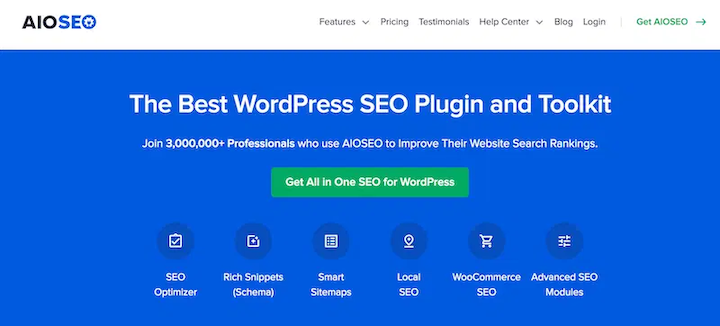
One of the best WordPress tools, especially for beginners, is an SEO plugin like AIOSEO.
As one of the most popular SEO plugins for WordPress, AIOSEO offers a comprehensive toolkit for on-page optimization and technical SEO implementations.
More specifically, you can use it for:
- Fine-tuning titles & meta descriptions
- Implementing XML sitemaps & rich snippets
- Social media integration for optimized sharing
- On-page analysis & guidance for keyword optimization
AIOSEO lets you specifically tailor product titles and descriptions. This means you can optimize for those high-intent keywords shoppers are using like “buy [product name] online.” It also helps you improve the readability of your pages and posts.
Easy Digital Downloads (EDD)
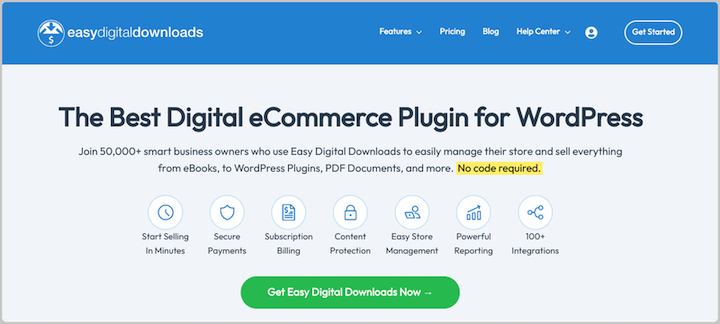
Easy Digital Downloads is the go-to eCommerce plugin for WordPress when selling digital products. It’s designed with streamlined handling of downloadable files and licensing in mind. As such, EDD can help with:
- Creating & managing digital product pages
- Ensuring smooth, fast checkout
- Incorporating high-quality images & clear descriptions
- Setting up payment systems
- Handling secure file downloads & license keys
EDD helps build search-engine-friendly digital download stores that are fast, easy to navigate, and secure. All of these factors help influence the trustworthiness of your website and online presence, which can affect your rankings.
Plus, EDD seamlessly integrates with a variety of WordPress tools and plugins, including AIOSEO, MonsterInsights, social and email marketing tools, and more.
MonsterInsights
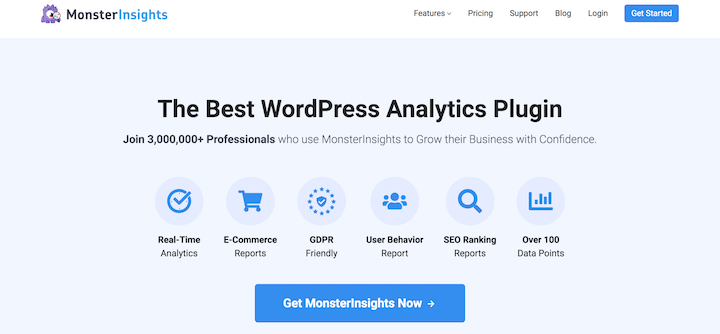
MonsterInsights is a powerful and popular WordPress plugin that lets you integrate Google Analytics with your WordPress site.
It can help with:
- Understanding where traffic comes from & how users interact with your site
- Advanced eCommerce tracking for purchases, cart events, etc.
- Revealing popular products & content on your site
- Tracking which search terms lead to sales, clicks, conversions, etc.
- Connecting to Google Search Console & other monitoring tools
This can help you track your website’s SEO performance and identify areas for improvement.
Google Keyword Planner
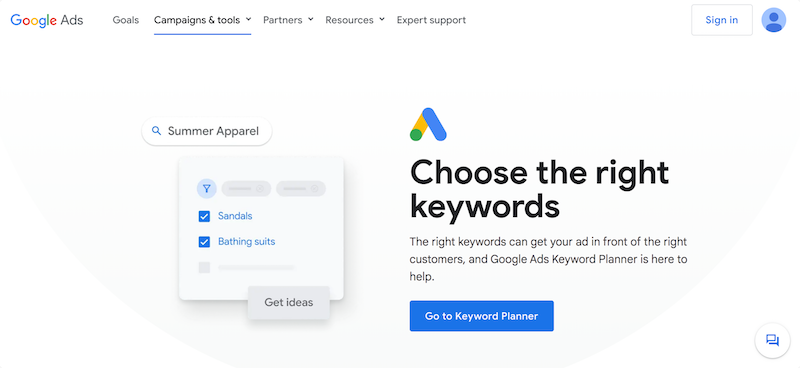
Google Keyword Planner is a free research tool within the Google Ads platform. It’s similar to premium alternatives such as SEMrush and Ahrefs.
Use it for:
- Discovering new keyword ideas related to your products
- Obtaining search volume data & competition levels for keywords
- Finding seasonal trends for particular keywords
This tool can help you identify the most searched keywords for your product category. Additionally, you can use it to pinpoint high-volume terms with purchase intent that you can target throughout your product pages and content.
Google PageSpeed Insights
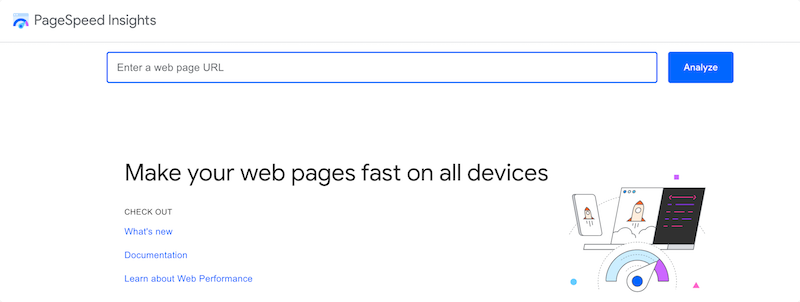
Earlier, I mentioned how important your site speed and performance can be in SEO for digital products and eCommerce websites. Fast loading times are crucial for both user experience and SEO.
Google PageSpeed Insights is a free tool from Google that lets you easily analyze website speed and performance.
With it, you can:
- Measure site load times on both mobile & desktop
- Identify specific bottlenecks, such as slow images or excessive code
- Get optimization recommendations
PageSpeed Insights helps you understand the changes needed, such as image optimization or compression, to keep your product pages snappy and search engines happy.
Use EDD to Boost SEO for Digital Products
By incorporating these suggestions and tailoring them to your specific needs, you can establish a sound strategy and improve your SEO for digital products.
Don’t have your online store set up yet? Download Easy Digital Downloads to get it up and running in no time!
📣 P.S. Be sure to subscribe to our newsletter and follow us on Facebook or Twitter for more WordPress resources!
Using WordPress and want to get Easy Digital Downloads for free?
Enter the URL to your WordPress website to install.
Disclosure: Our content is reader-supported. This means if you click on some of our links, then we may earn a commission. We only recommend products that we believe will add value to our readers.
Thank you for giving us information